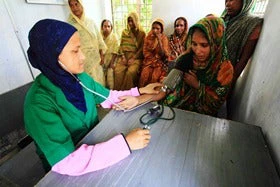
The key challenge facing foreign aid globally is its effectiveness.
Research on aid effectiveness has focused on outcomes such as a country’s economic growth or quality of institutions. These studies came to mixed conclusions over whether aid can effectively promote economic development.
Microeconomic evidence paints a reasonably positive picture. The World Bank’s Independent Evaluation Group (IEG) finds that the average rates of return to aid are generally above 20%. Evidence based on randomized program evaluation techniques is also largely positive, indicating that aid-financed interventions can generate substantial benefits for individuals.
The most common approach to evaluating the macroeconomic impact of aid examines the relationship between total aid flows and the economic growth rate. Normally, this has been done with the expectation that, other things equal, countries receiving more assistance would grow more rapidly. Early prima facie evidence suggested the opposite: countries that received the most aid also grew relatively poorly—a paradox often referred to as the micro-macro paradox.
A large number of studies attempted to demystify this paradox. When countries do well for a while, average incomes increase. Donors then tend to transfer less aid. This implies that, over time, the best performing countries receive less aid and the worst performers receive more. A leading study of the World Bank argued that although aid has no impact on growth on average, it can work as long as recipients pursue ‘good’ policies. This result suggested how donors and aid recipients can learn from mistakes in the past to improve aid effectiveness in the future. However, the upshot of the studies that followed suggested aid “is probably not a fundamentally decisive factor for development”.
Recent theoretical exercises give further weight to the need for modest expectations regarding the magnitude of the possible impact of foreign aid on growth. Overall increase in the growth rate accruing from aid inflows of 10 percent of GDP may only be 1- 2.5% depending on the share of aid that is invested and productivity impacts. These effects are very difficult to distinguish from business cycle fluctuations and external shocks at the levels of aid seen by most countries.
The discussion about whether foreign aid works takes place in two platforms. One is the research platform, in papers full of technical language and numbers. Outside, the arguments are plainer and the audience broader. It is far easier to evaluate a school-building project, say, on whether the school was built and children filled its seats than to determine whether all aid improved national school enrollment or made the economy grow faster. The biggest challenge is to show not just that aid went hand-in-hand with economic growth, but caused it.
The one challenge on which views appears to converge is the importance of strong government leadership as well as effective and efficient public institutions as critical ingredients to ensure aid effectiveness. The international development community has been grappling with this problem for decades.
Most aid effectiveness reforms over the years have been focused on improvements at an operational level-- improving management, coordination, evaluation, and project design for technical or capacity-building. These solutions usually miss the underlying political dynamics that block real change. The more fundamental problem undermining aid effectiveness is the assumption that poor governance, weak institutions, and fragile conditions can be fixed through technical assistance. The roles of powerful actors who use their influence to prevent change are typically treated as external to assistance programs, if not ignored altogether.
Development assistance models tend to focus on limiting the power of elite actors through institutional means like anti-corruption bodies or formal legal and judicial institutions. Unfortunately, in too many cases, powerful elites are able to ignore or capture these institutions. Aid effectiveness can be enhanced by shifting the focus to the interests of elite actors, identifying where the interests of certain elites might be served by advancing selected reform, and working to draw those elites into alliance and collective action with others.
This is easier said than done. Advancing reforms will still involve a struggle against powerful actors defending the status quo. But the chances of success are brighter when other powerful elites are on the reform side. In this context, it is important to understand the interests of powerful elite groups, and identify scenarios where they have a shared interest in advancing a set of particular reforms.
Many international development organizations are not adequately equipped to work effectively on these issues. It requires the capacity to acquire a thorough understanding of the range of local actors and institutions, and the history of power struggles in the country, as a foundation for gauging the current environment. It also requires drawing on other disciplines such as social anthropology and political science. The distribution of aid benefits can be heavily influenced by the political interests of those in power inside and outside the government. By overlooking these issues, aid may be slowing down the process of change by contributing to corruption and impunity.


Join the Conversation